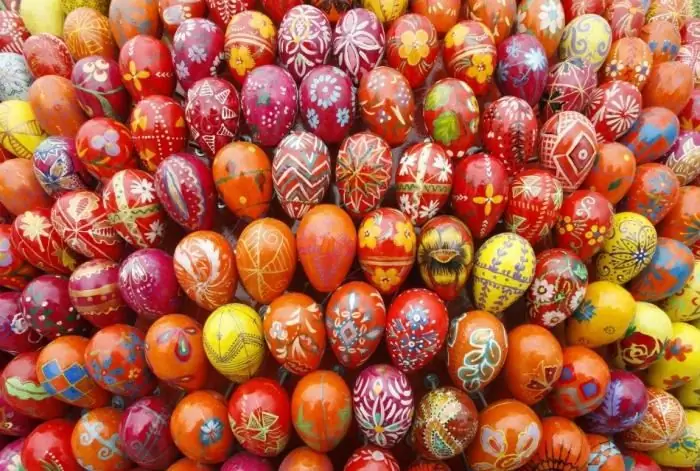2026 Author: Priscilla Miln | [email protected]. Last modified: 2025-01-22 17:55:15
The tradition of painting eggs for Easter dates back almost two thousand years. It is no longer possible to determine for certain why the decoration of Easter eggs with their own hands has become so common in the Christian world. There are many legends explaining this custom. Not all interpretations are directly related to the Resurrection of Christ and to Christianity in general. Most of them belong to pagan times, when the egg was considered a symbol of fertility. With the advent of spring, in ancient times, they began to paint eggs, decorate them in all sorts of ways to appease the gods and grow a good harvest.

But there are many Christian traditions that tell about the beginning of this centuries-old tradition. The most common is the legend of Mary Magdalene, who brought the emperor Tiberius after the resurrection of Jesus a chicken egg. He did not believe her story about the Resurrection, saying that such a thing would become possible if the brought egg turned red. This was immediately fulfilled, and red has since become the traditional color for decorating Easter eggs.
According to another legend, red Easter eggs are the blood of the crucified Christ, andbeautiful patterns on them are the tears of the Mother of God. After the death of the Lord, believers kept every drop of his blood that fell, which became hard as a stone. When he was resurrected, they began to pass them to each other with the joyful news "Christ is risen!"

The third version tells about the childhood of Jesus Christ, who loved to play with chickens. The Mother of God painted their eggs and gave him instead of toys. With a plea for mercy, she came to Pontius Pilate with an offering of painted eggs. But they fell out of her apron and spread all over the world.
There are legends that are not related to religion at all. So, for example, one of them tells that on the birthday of Marcus Aurelius, a chicken laid an egg with red spots. This event was an omen of the birth of the future emperor. Since then, the Romans have developed the custom of painting eggs and sending them to each other as gifts. Christians adopted this tradition, putting their own meaning into it.
There is a more practical explanation. During Lent it is forbidden to eat animal food, including eggs. But the chickens keep laying. To keep the eggs from spoiling longer, they were boiled. And to distinguish boiled eggs from raw ones, they were dyed.

Be that as it may, the tradition of painting eggs has survived to this day, gathering the whole family for this activity. Many customs, rituals and beliefs among Christians are associated with already painted eggs. Even mystical properties were attributed to the consecrated Easter egg. It was believed that it could put out the fire, preventdiseases of cattle and make its coat smooth, return a loved one, save it from theft, drive evil spirits out of the house. Having dipped krashenka into the water, the girls washed themselves with this water in order to preserve their youth and beauty. Easter egg shells were scattered across the field to ensure a good harvest.
It is unlikely that anyone will be able to accurately prove or disprove the miraculous power of Easter eggs, but some traditions of antiquity have come down to us. Until now, children's favorite pastime during the Easter week is rolling painted eggs down a hill. The Easter meal begins with them, and friends and acquaintances are given the most beautiful eggs with the good news “Christ is risen!”
Recommended:
How to color Easter eggs

Easter egg is a must for the Easter holiday. On this bright holiday, they occupy the main place on the table, they are eaten first, distributed to the poor, given to friends and family, and also left in the church
Eggs for Easter: the history and traditions of the holiday. Why are eggs painted at Easter?

Preparation for such a great day is no less grandiose event than the holiday itself. Painting eggs, cooking Easter cakes are symbols of Easter, without which you can’t
The history of the bag from its origins to the present day

A bag is not only a product designed to carry items. It is also an accessory with which a person can emphasize his individuality. The history of the bag began in the days of the primitive communal system. It is still being written, since a full-fledged replacement for this device has not been found. What path did the products take?
International Mother Language Day: origins, celebration, perspectives

To paraphrase a well-known classic, we can say: “Native language… How much has merged in this sound for the Russian heart! How much it resonated!”
How to paint eggs? Let's turn on the fantasy

Easter is perhaps the most favorite holiday not only for children, but also for adults. Everyone can show their imagination by making crafts from eggs with their own hands. The main thing is desire and a little creative thinking

